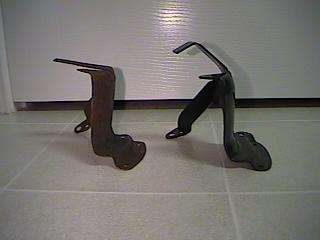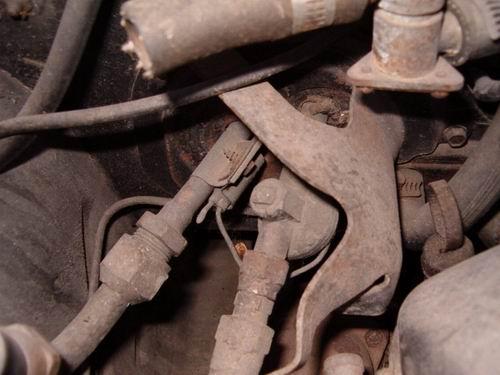Air Conditioner Valve and Heater Motor Shield
Due to the size of FE-series engines and the close confines of the Mustang engine compartment, Ford found it necessary to mount a shield (identified by basic part number 19C842) to protect the heater blower motor (for cars without air conditioning) or the air conditioning expansion valve (for cars with air conditioning) during engine and transmission installation on Mustangs equipped with a 390, 428 CJ, or 428 SCJ engine. This shield is made from stamped steel and is typically painted the same semi-gloss black as the firewall itself. There are no stamped or cast identifying numbers on the shields, but the service part numbers are described in Ford's Master Parts Catalog (MPC) and the engineering numbers can be cross-referenced from the service part numbers. Interestingly, the 1970 Osborn electrical assembly manual (published by Jim Osborn Reproductions and available from most Mustang parts vendors) includes this note:
"AFTER ENGINE DECKING IS COMPLETE AND BEFORE STARTING ENGINE, REMOVE SHIELD & REPLACE EXISTING SCREWS (ITEM-13)"
This suggests that the shield was supposed to be removed by a line worker after the engine and transmission were installed, with the worker reinstalling the screws used to secure the shield. Perhaps Ford accountants wanted the shield re-used to reduce assembly costs. I suspect, though, that a great many of these shields were left in place instead of being removed due to the time and energy required to remove it once the engine was installed and space was reduced to near nothing. Observations of original cars indicates that there were four different shields in six different configurations, though not all of the shields were available as service parts. Here are the known engineering and service part numbers:
| Application | Engineering Number | Service Part Number |
|---|---|---|
| 1968 428 CJ | C7ZA-19C842-A | C7ZZ-19C842-A |
| 1969 and 1970 390 and 428 (except 428 CJ) | C9ZA-19C842-A | C9ZZ-19C842-A |
| 1969 and 1970 428 CJ | C9ZA-19C842-B | C9ZZ-19C842-B |
Observations of original cars indicates that there were four different shields in six different configurations, though not all of the shields were available as service parts. There were different bases used to mount the shields on 1967 - 1968 firewalls vs. 1969 - 1970 firewalls, and two different extension arms, or "fingers", used to protect the heater motor shield or air conditioning expansion valve. The fingers could be either cut off, pressed flat, or extended with a slight bend at the end. The versions with a long finger were used on cars equipped with air conditioning. The versions with a clipped or flat finger were used on cars without air conditioning.
Top view of firewall shields.
C9ZA-B version at left, C7ZA-A version at right.
The Osborn assembly manuals illustrate a part that looks like the shield show above on the left. Note the differences circled above. The mounting surface and holes (circled in red) are slightly different, and the version on the right includes a long finger (circled in yellow) to protect the air conditioning expansion valve. This finger is absent on the version to the left. The C9ZA-A shield has the long finger of the C7ZA-A shield and the mounting base of the C9ZA-B shield.
Here's a comparison of the two different long finger styles. The shield on the left has the 1967 - 1968 mounting base and a long, flat finger for use on a car without air conditioning. The shield on the right has the 1969 - 1970 mounting base and a long, bent finger for use on a car with air conditioning.
 |
 |
Wayne St. Jean found a flat-finger style shield on a '68 Shelby GT500 KR. Here's a picture:
Finally, here's an example of a long-finger style shield used on an S-code (390) Cougar equipped with air conditioning. Here's a picture (courtesy of Garey Maib); note the necessary bend:
Use the long-fingered style if you want to use a shield and you have air conditioning. Use the no-finger or flat-finger style if you don't have air conditioning. Don't use one at all if you don't want one, and tell any judge that complains that the assembly manuals clearly state that they should have been removed after the engine was installed!



